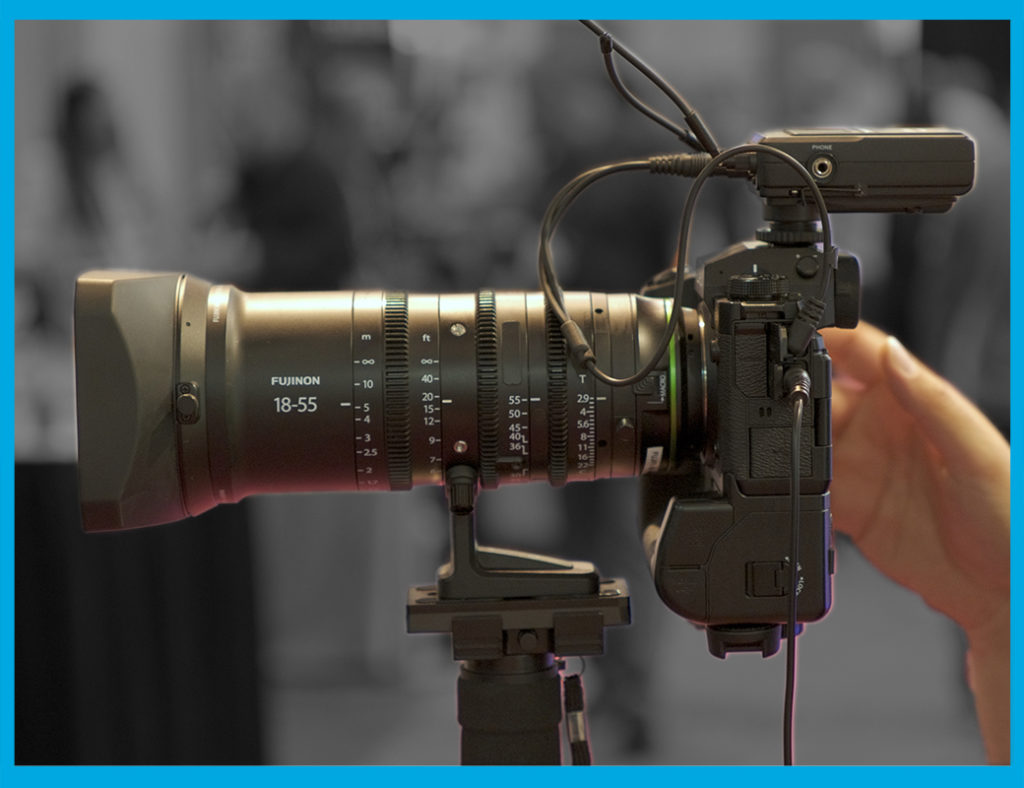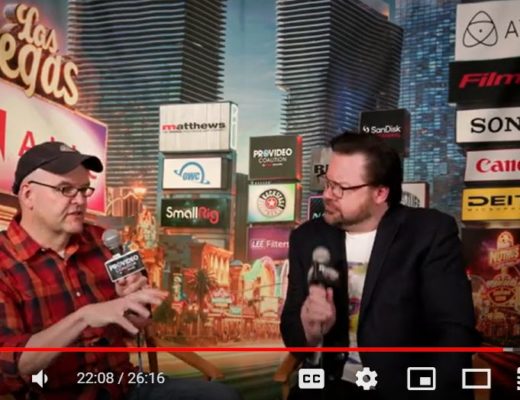NAB 2023 is behind us and now that everyone’s fully recovered from the fun, excitement, and lack of sleep I can tell you all about our experience with the Camera to Cloud workflow we were using for our coverage and the FUJIFILM X-H2S system. You can check out our coverage on the ProVideo Coalition YouTube channel here (and be sure to subscribe for more!). While that playlist essentially covers our… coverage… and there’s been individual posts about each video here on PVC, I wanted to run down the gear and workflow side of things because I think it’ll be beneficial to those of you who might try do do your own event coverage, or at least find this kind of nerdy, weeds-y stuff interesting.
First off, if you know anything about me you know I’m a big fan of both the entire line of Fujifilm cameras as well as the emerging tech behind C2C. Cameraman Adam Greene and I have yelled from the rooftops about how useful C2C can be since we first deployed it at Cinegear 2022 and our excitement hasn’t changed as new additions to the workflow seem to be added every month. That being said, we did learn a few things this trip as NAB was a particularly challenging environment. While the content is fantastic and I’ve gotten great response from our coverage, the execution was rocky at times. Hopefully this article will help you pull off something like this, if you were planning on it, but even if you’re not I bet something in here will ring true and be beneficial. That being said, we’ll start with…
THE GOOD STUFF
The Results
Before we get into anything, I have to say the end product is exactly as we set out to create. Every interview we did was fantastic, the people we met and the products demoed were super cool, Cameraman Adam and Editor Alexander Jones absolutely knocked it out of the park, and I personally think we made a wonderful supplement to any existing coverage out there that I was told a number of times from the folks we were talking to could feel a bit stale. I think we were able to have a more real, honest discussion with our subjects that didn’t feel as “newsy” as some other outlets made and that enables you, the viewer, to get a more nuanced look at any given product or service. My goal was to not be combative, obviously, letting the companies pitch their stuff but also to be inquisitive and friendly, hopefully getting “past the press release” and into questions you or I might have that wouldn’t be covered by a simple talking head booth presentation. I think we delivered there.
The Camera
One thing I, and most folks, love about the Fujifilm series of cameras is the film simulations. Not that I know for sure that they accurately emulate any given film stock, but it allows you to basically “color grade” in-camera. This is awesome for photography, and you don’t have to look far to see the amazing results people are achieving there, but for something like this it was great to be able to dial in the look as I wanted it so Editor Alex didn’t have to worry about correcting anything and could just focus on assembly and upload (he did incredible by the way, go check out how polished those videos are, for real).
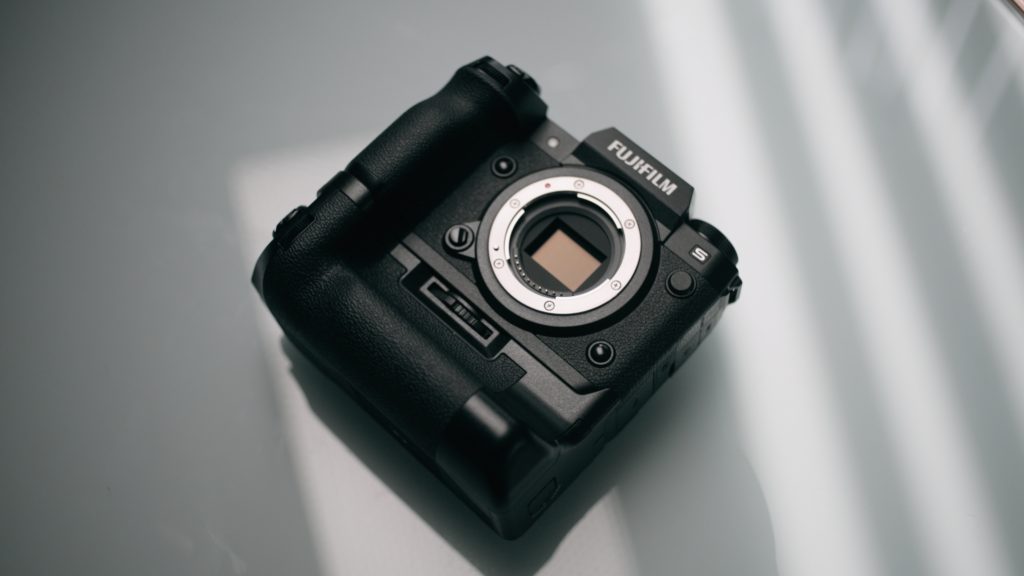
For something like event coverage or news gathering or whatever you don’t need log (and certainly not the 10bit 4:2:2 6.2K the X-H2S is capable of) but if you’re planning on going to “broadcast” with the C2C proxies, something like the amazing new Flog2 curve won’t be properly served, in my opinion, by the limited 45Mbps bitrate. Even though ProRes Proxy is 10bit, in the interest of speed we used the Eterna simulation with the shadows and saturation boosted a bit and the highlights brought down so as to account for the convention center top-down lighting creating any deep shadows or poppy highlights. We also nixed the noise reduction and sharpness, setting those to their absolute lowest values, as I’ve found I get a cleaner image that way. They have their purposes obviously but as a preference I just turn those off. Worst case I can de-noise in post but I haven’t found that to be necessary with a properly exposed image. As you can see in the final videos, the end quality is fine and actually YouTube did more damage to the videos than the Proxies as we were uploading in 1080 (you can get away with up-resing to 4K a lot of times to get around YouTube’s poor HD encoding).
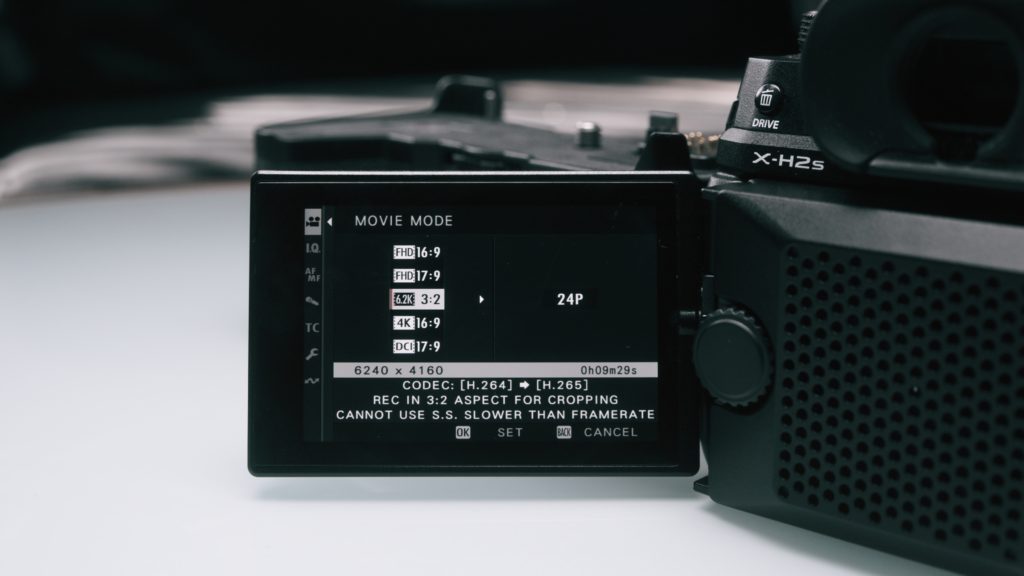
Another nice thing is the X-H2S doesn’t have a clip length limit so, although it only happened once, any interviews over 30m wouldn’t get cut off. For live event coverage or similar that’s actually huge, and an oft-cited downside of using DSLR/Mirrorless cameras for certain gigs. Fujifilm cites 240min of runtime at 4K 60p if your memory card and batteries can handle it.
The Lens
Not much to say here really, the Fujinon MKX 18-55mm Cine Lens is a surprisingly lightweight beast that I’ve talked about before and since it opens to a T2.9 we weren’t wanting for more exposure, shooting around 800-1250ISO which gave us a nice clean image. The optical quality is near perfect with no breathing, vignetting, CA or anything to speak of and gave us a tack-sharp image even wide open which further helped our “proxy” workflow look its best. They also have a really pleasant falloff and smooth bokeh/out of focus area, although those weren’t particularly highlighted in these simple interview scenarios with me up against a booth wall more often than not.
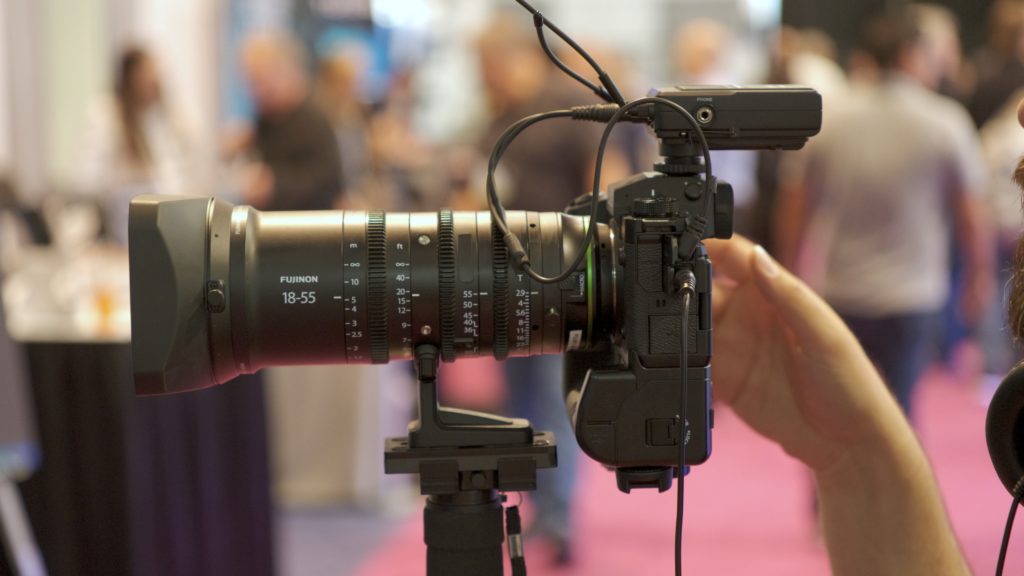
Obviously as they’re cinema lenses there’s no OIS, but since the X-H2S has IBIS Cameraman Adam was able to hop off the monopod and go handheld or even just move with the monopod attached when necessary without having to worry about any shakiness or anything. It also made the monopod footage rock-solid, which was nice.
The File Transfer Grip
The main reason we went with this system was the new File Transfer Grip available to the X-H2 and X-H2S. Whereas before we needed a Teradek, Atomos Connect, or Similar to enable C2C functionality, with the grip everything is self-contained. The grip enables both wifi and ethernet connection so you just set your internet source in the camera menu, connect it to your Frame.IO project (which is done rather simply with a QR code and your phone), and you’re good to go. Aside from being a transfer device, it also acts like a normal battery grip with all the buttons you’re used to as well as the addition of two extra batteries, although those batteries are focused on keeping the grip itself going when you’re using C2C so you do lose out on some of the standard shooting-longevity benefits there. That being said…
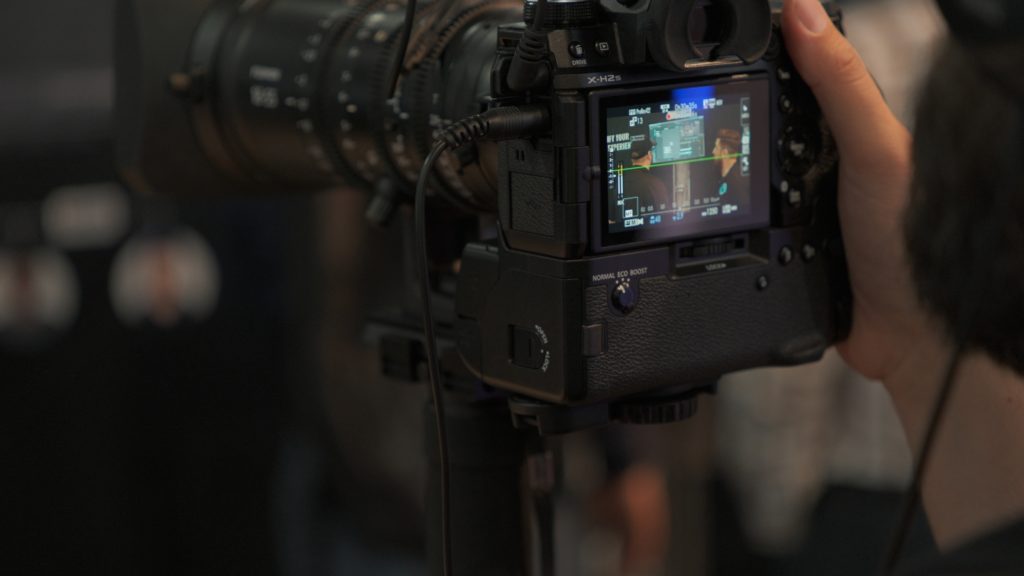
The Battery Life
Even though the grip batteries were doing grip tasks, the camera itself actually ran all day on the one internal battery which we thought was pretty incredible. Obviously the camera was sipping power from the grip as well, but we actually never had to change the main battery even though we were leaving the camera on all day and shooting near non-stop from around 10am to 5pm. The camera also didn’t overheat, even in tests where we left it going as long as it could, so that was nice.
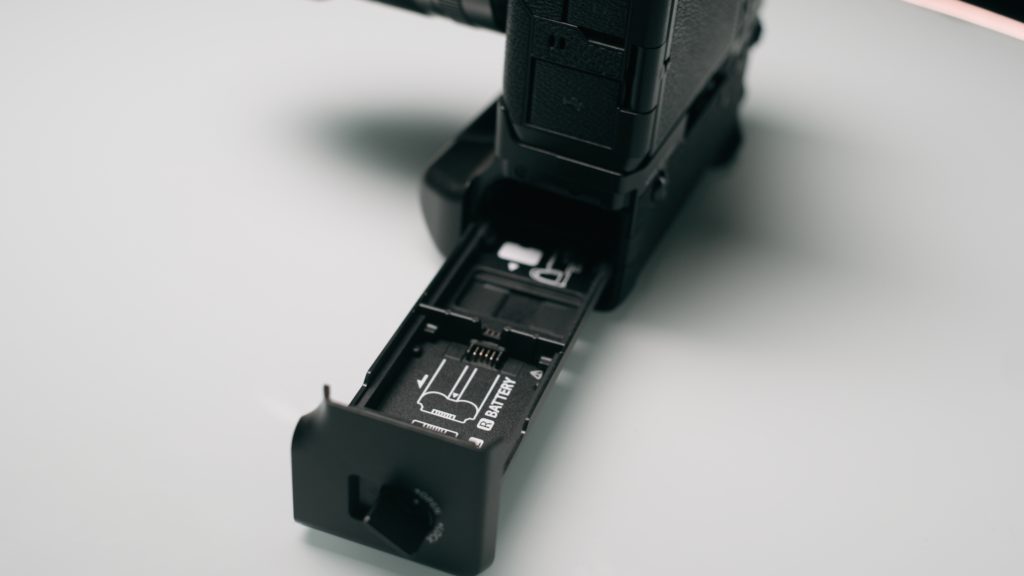
Ergonomics
Obviously, one advantage to shooting with a mirrorless camera is the size. Our previous conference coverage was done with a C500mkII and a Teradek Cube 655 and while that’s not an enormous camera, it certainly can get tiresome after 8 hours of running around. The X-H2S coupled with the aforementioned light weight cine zoom didn’t tire us out and was easy to pass between each other if needed anyway. The X-H2S is more “standardly mirrorless” in layout, as opposed to something like the X-T5 which has a more “film classic” body with more dials dedicated to things like ISO and the like, but still has easily legible and universally customizable buttons allowing you to manipulate any of the settings without having to go menu-digging. It’s also got a nice deep grip which most people seem to prefer (I’ve got tiny hands so the smaller grip on something like my X-T3 or X100V isn’t terribly difficult to wrangle).
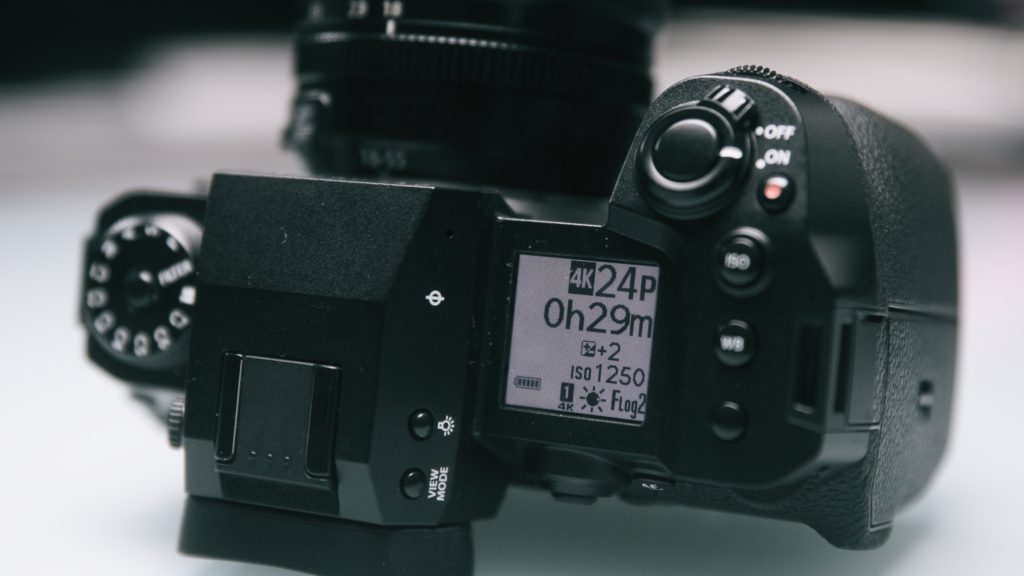
One thing I’d like to see is a waveform, as opposed to the histogram it already has, and Cameraman Adam said he would have liked a bit more “peak” on the focus peaking, but hopefully those things can be added in one of Fujifilm’s constant Firmware updates. Worst case, especially for a narrative type gig, you can just employ an external monitor. And that sort of dovetails us into…
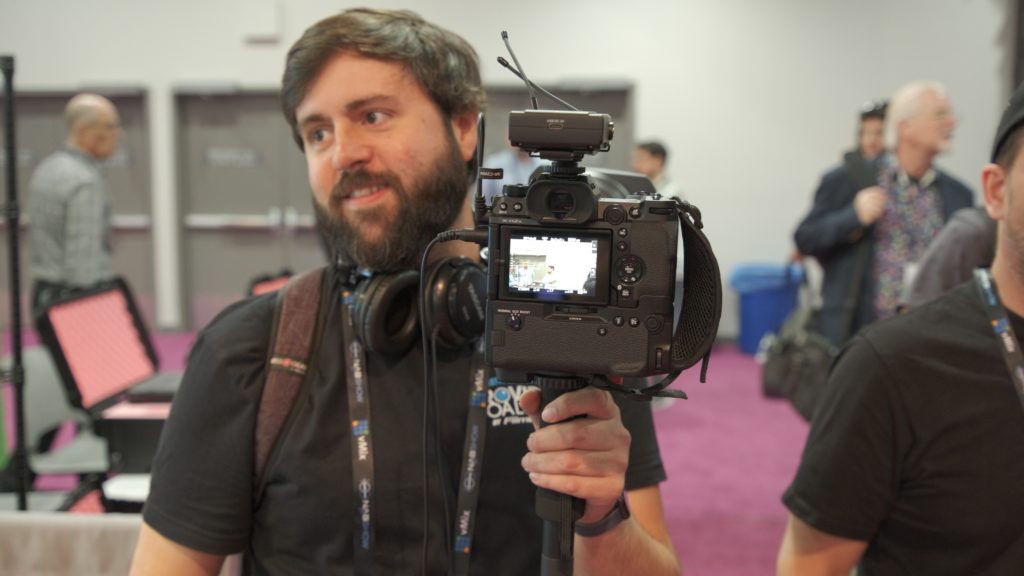
THE STICKING POINTS
Firstly, and this is on me, I mentioned in my announcement article that scheduling was difficult last NAB and this year I used Calendly to book everyone. That was a great idea and resulted in a full slate of interviews but I didn’t account for any time to address hangups as we hadn’t really run into them before and for whatever reason I was feeling particularly confident. In this case it was the wifi connection in the convention center. Apparently everyone from vendors to speakers was having trouble getting online, not just us (even with our dedicated unit) and that meant the “cloud” part of C2C was hindered. We were able to get maybe half of our interviews to Editor Alex, but the other half we had to edit ourselves when we got back home and this highlighted a few things to consider when utilizing this system.
In every article or discussion I’ve had about Camera to Cloud, I’ve mentioned how wonderful it is to have as a “third backup” and also to have a fresh set of eyes in the form of your editor or AE to let you know if something’s up with your footage as soon as you shoot it. At Cinegear 2022, for instance, our editor and PVC contributor Scott Simmons was able to tell us we had an audio issue with our first interview and we were able to go back and re-do it immediately, saving us the embarrassment of getting home and realizing it too late. In the case of NAB 2023, I wasn’t considering C2C to be a backup but our main workflow. I’m a big proponent of the “two is one, one is none” philosophy and in my excitement to get going let that idea slip. In a situation where you’re not in a wireless faraday cage like the Las Vegas Convention Center it’s likely not an issue, but for us it was. Next year (where I’ll absolutely be taking another crack at it) this is what my plan is:
Scheduling
This was my biggest mistake but luckily has a simple set of solutions. I naively assumed 15 minutes between interviews was enough to get to the next one, but that was banking on the idea that we wouldn’t need to do any gear maintenance and that every booth would be ready to go when we got there. This was not the case.
We’ll go through the gear stuff below but for everyone’s sanity I just needed to schedule one interview an hour as opposed to every 30 minutes. This would allow us to account for other interviews going over time, subjects not being ready or present, or any other unforeseen circumstances (like, for instance, waiting for the end of a loud PA-assisted presentation happening right next to the booth we were attempting to talk to). This would also mean that if we did get an interview done on time we could find another booth that wasn’t on the predetermined list to chat with and potentially find some hidden gold.
Another scheduling snafu, and again for whatever reason I thought 15 minutes was plenty of time to do this, was doing back-to-back interviews in different halls. If you’ve never been to the Las Vegas Convention Center there’s actually 4 major sections: South, North, Central, and the dreaded West Hall. The bulk of the conference takes place in the North and Central Halls, which are basically right next to each other, but it’s like a 5-10 minute walk to the West Hall from there and there were a few instances where I had meetings go North, West, North, Central, West, West, Central, West etc. That was a HUGE time suck but did net us about 23,000 steps a day which was a… bonus?
Next year I’m going to schedule one interview an hour and dedicate each day to a single hall, allowing us to not only get our slate of interviews in without having to reschedule or cancel, but also giving us time to find smaller companies to talk to when we do happen to have spare time. In a perfect world we’d have a second team doing interviews as well so we can double-up and get even more coverage, but we’ll worry about that when I get this workflow dialed in haha
Bigger Memory Cards
We had plenty of cards but they were all 325GB in size. This wouldn’t be an issue generally and actually is a great idea for footage security as if one card gets corrupted you only lose a handful of clips and not your whole day’s shoot, but when using C2C you need to have the card in the camera to transfer, obviously. Since we were shooting back-to-back interviews essentially non-stop, the spotty internet wasn’t allowing us to get the footage to Editor Alex in time before swapping cards. Obviously that means the transfer of the footage is canceled and a new transfer begins with whatever you’re shooting on the new card. Luckily this didn’t result in half of an interview getting out or anything like that, but it certainly wasn’t ideal. I also had us shooting in 4K thinking we’d need the footage later for some reason (and that did help us identify certain people by their badges which may have been illegible in HD) which filled up the cards faster than necessary. Obviously the already-wonderful looking proxies are going to Editor Alex in 1080, but there was no reason to shoot 4K on a gig like this.
Next time I’m going to bring 1TB or greater cards to make sure our transfers can keep going out as we shoot and we’re going to keep it at 1080p.
Use the Hardware
We actually had two cameras in case one went down for whatever reason, as well as to allow us to shoot B-Roll of our coverage simultaneously, but since I was crunched for time I didn’t think to use the other body for transfers. Had I given us more time between interviews we could have stopped and ran to the Filmtools booth and just sort of “set and forget” a camera to only focus on transfers, or just pick up the other body and leave the first one to keep working, but we were on a train that wasn’t stopping.
Solution here is to simply have me carry around the second body and swap out if/when a card fills up. Although alternatively we could have used…
A Third Person
Cameraman Adam and I were running this thing solo (duo?) where he was focused on the camera stuff and I was focused on the interview and scheduling stuff. This works in theory but we really did need a third person there to offload tasks on to when we needed divided attention. For instance I was constantly attempting to communicate with PR teams via email/text while also running from booth to booth and obviously couldn’t do so while conducting the interview so any time we hit a snag that needed both of our energies, or I simply needed to put my head down and fire off a bunch of correspondence, we could feel the absence of an additional set of hands. This person could have also ran off and got us that second camera while we kept recording, or monitored that bodies transfer status in a pocket of good wifi, which would have been huge.
Next convention I’m going to see if we can’t get an AD/PR person to handle that type of stuff so Adam and I can simply focus on the production side of things but even if we can’t, the wider schedule and tighter geographic movement will be hugely beneficial. It’ll also be nice to have that person be “the bad guy” and keep us on schedule as I can be kind of excited and chatty.
Backups/WiFi
This was our main snag. The Convention Center was just a nightmare of wireless signals and dead spots, and that’s not really anything we could control. Our tests at home went flawlessly, footage transferring to our Frame.IO project nice and quick even out at a park and obviously in our respective “offices”, but the LVCC was a worst-case scenario for this type of workflow.
We had a Sclera unit (basically a giant wifi tower in a backpack) but that was really struggling to get through the concrete it seemed. We also had a dedicated C2C wifi access point that spanned the majority of the Center and North halls, but that didn’t get dialed in (for us at least) until the second day which had the majority of the 65,000 attendees present so the coverage was really getting beat up. We were also doing a final “battle/beta test” of the handgrip to give notes to Fujifilm about before they went live with a new update, so we weren’t on production firmware which didn’t really matter except for the fact that it could only remember one connection at a time. This meant that attempting to switch between the Sclera, C2C wifi, or a different hot spot essentially involved a reset and took more time than I’d allotted (not thinking we’d even need to be doing that). Fujifilm already knew about this before giving us the hardware and the production firmware that’s going to go out won’t have that particular issue so no worries for you there if you’re planning on getting one, that’s just how beta testing goes. Otherwise the grip worked great, and they’re adding a few other notes of ours as well so as far as a test things actually went really well! I’d be more nervous if we were on beta firmware and found nothing (“where are those bugs hiding!?”).
In terms of Backups, I mostly mean that I was relying solely on the C2C workflow and didn’t have an alternative. Have you ever been leaving your house and thought “ooh I wonder if I should grab… nah I won’t need that”? Every. Single. Time. I have that thought, I do “need that” and in this case it was a CFexpress reader. Had I just grabbed my reader we could have just gone to the hotel or even the press room and dumped the footage to a drive and started uploading it to Frame.IO “manually” which usually goes pretty fast. Problem solved. Instead we had one camera connected to hotel wifi (slooooow) doing C2C transfers and another camera plugged directly into my laptop using the wrong cable (in this case, a USB-C but USB2.0 speed cable intended for charging) dumping the footage to my harddrive so I could then do the aforementioned manual upload to Frame. That took way too long.
This really was a dumb mistake on my part. Next year it’ll be simple enough to just bring a card reader and I’ve already invested in a handful of guaranteed USB-C 3.2 speed cables because while USB-C is a wonderful standard, cables don’t seem to be labeled and you never know what you’re using: Thunderbolt? USB2? 3.x? I need to talk to the USB Consortium… USB-A 3.0+ cables at least have that blue bit that you can visually confirm with. I’ve started going through all my USB-C cables, testing them, and marking them with color-coded tapes just because, even outside of this project, I simply can’t tell which is which!
In any case, next year our delivery plans, in order, will be: C2C, Offload on-site, Offload off-site, and “Edit at the hotel”. That’ll be plenty of alternative solutions in case one of them doesn’t pan out and in this specific instance we could have had all but maybe the last 5 interviews in Editor Alex’s hands had I just had my card reader/cables. Ya live and ya learn, right?
Wrap-Up
Overall, foot pain and headaches aside, I think we did what we set out to do. Sure, we couldn’t account for LVCC’s internet situation on the floor, but this experience really reminded me to always assume Murphy’s Law is in full effect and to have multiple backups. If two is one and one is none, then technically you need three minimum contingency plans! Luckily I made that mistake so you don’t have to
In terms of Camera to Cloud and the FUJIFILM X-H2S, I will hopefully be employing them at next year’s convention (or even Cinegear coming up here soon!) with my new best practices in place and things going a lot smoother. While I’m a relatively accomplished DP and very tech-literate, if anything this experience really just goes to show that no matter how up-to-date you are on the hardware and workflows you’re deploying on set, the person who’ll really save your butt is…
A good AD.
